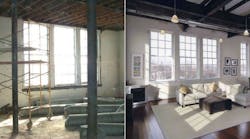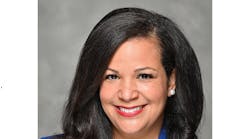Everyone knows that a school is about so much more than reading, writing, and arithmetic. It is an important part of a community and the repository of special memories for students and alumni. So it is easy to understand why people often react so strongly when schools close, and just as strongly when the discussion turns to what to do with those decommissioned schools.
It is always sad when a school must close its doors or sell any of its property but with increasing tuition rates at the college and university level, decreasing populations, aging school buildings, and economic problems in many urban areas, more and more schools are having to do just that.
Morris Brown College in Atlanta is currently looking at ways to keep its doors open. The historically black college and university has been struggling with debt since the late `90s, when its administration misused federal funds, according to Anne Aaronson, attorney for Morris Brown. No money was stolen, but funds intended for student financial aid were appropriated for school expenses and operating needs rather than student use. “It wasn’t stolen for personal gain,” says Aaronson.
As a result, the school lost its accreditation in 2003, which set off a series of events that led to bankruptcy. Since then Morris Brown has been considering selling off some of its property in order to resolve its debt.
Most recently the school, which is down to 35 students, turned down a $10 million offer from the City of Atlanta. The 35-acre campus, which is mostly boarded up, sits near the site of the new Atlanta Falcons stadium, an area slated for over $1 billion in investment from the city. Aaronson says Morris Brown is now reconsidering the city’s offer, along with any other bids, through Jones Lang Lasalle, an Atlanta real estate and financial firm.
One potential issue Morris Brown may face is the fact that Clark Atlanta University made a land grant to the school with the stipulation that the land could only be used for educational purposes. The school is sidestepping that issue for the moment, focusing on securing a suitor first. “We hope that we will come up with a solution that we all can live with,” Aaronson said.
The bid deadline for entities interested in purchasing property for Morris Brown is April 30th.
School of Hard Knocks
When a college is in trouble it can choose to pursue different options, such as selling off parts of its property or leasing out some of its buildings, as Morris Brown did with the Interdenominational Theological Center in Atlanta, whose campus is adjacent to Morris Brown’s. But the situation is very different when a K-12 school is forced to close.
The closure not only impacts the school administration, but also affects the community around the school, city planners, and, in some cases, preservationists. There are a number of things that must be balanced when undertaking adaptive reuse of a decommissioned school.
You have to consider “sustainability, community pride, and the identity of the community,” among other things, says Harris Steinberg, a fellow of the American Institute of Architects and the founding executive director of PennPraxis, the clinical arm of the University of Pennsylvania’s School of Design.
Steinberg recently oversaw a group of eight city planning graduate students at the School of Design who were working with the Philadelphia School District on disposing of schools that were being decommissioned. The city accepted their recommendations and is, for the most part, using the process they created, according to Steinberg.
Schools that fall into the prewar category “are very simple structures” that are “easily adaptive to other uses,” Steinberg says. “Older buildings were well-built. They were built during a time when we were investing in our public infrastructure. We kept it simple and used good materials. They were built to last.”
Accordingly, decommissioned schools in Philadelphia have been reclaimed for a multitude of purposes. Perhaps ironically, one of the more popular adaptive reuses has been alternative educational facilities, particularly charter schools. But “residential outpaces most of the others,” says Steinberg, adding that other popular redevelopment options include office space and artist studios.
Residential spaces work best in areas that Steinberg defines as “on the edge.” Rapidly gentrifying areas are no brainers, he says. But he points out that 75 percent of decommissioned U.S. schools are not in those areas. The question then becomes, “How do you create a process that is equitable and fair?”
Steinberg advises that all parties work to foster “significant civic engagement up front so that the community is involved in a way that is honest.” Accepting market realities is key, he says, ensuring that the project and its offerings are not “pie in the sky.” Furthermore, all information about potential development should be disseminated to the community and to the real estate market in a way that is transparent, he says.
Perhaps the most important thing to do is to establish a timeline so that the project is not open ended, says Steinberg.
Motor City Makeover
Like Philadelphia, the Detroit Public School System has also had to manage a swath of decommissioned schools. In addition, the Detroit school district has faced extreme financial constraints that have forced several hundred schools to close and real estate conditions that have made developing those schools a challenge.
In March the district gathered key players for an event it called “Old Schools, New Uses: Property Developers Conference.” This conference was “notably different” from prior similar conferences, says Steven Wasko, assistant superintendent, community relations for Detroit Public Schools. “This conference had a much higher preponderance of developers interested in the purchasing the property, and fewer planners in attendance.”
In addition, there were a large number of attendees from out of town and from out of state, fostering a much different economic environment, and one that promised a greater likelihood of developing decommissioned properties.
Of the more than 200 schools that have closed in Detroit, only four have been adaptively reused to date, Wasko says. The school district hopes that the conference attendance is an indication that that rate will pick up considerably.
As in Philadelphia, the areas of Detroit seeing the greatest amount of redevelopment are areas undergoing broader gentrification. But in communities that are not seeing significant redevelopment, a decommissioned school can be blight on the neighborhood.
“A vacant building in an urban area is a challenge for area property owners,” says Wasko. In addition, an empty school creates more strain on an already tight school district budget. There is a need to keep the buildings secure so that they can retain value, he says, as well as not become a haven for crime.
“Where the school was once a positive it becomes a center that is a source of blight or is a negative draw,” Wasko says. “That is what is exciting about the fact that the climate seems to be changing.”
Currently the Detroit Public School System has 88 buildings and 36 parcels of land for sale. Wasko says there are early signs the district is entering a new period, buttressed by a $5 million fund established by the Local Initiatives Support Corporation that will function as a pool of resources for developers who purchase a Detroit public school.
Telling a Story
While planning how to unload decommissioned property can be a challenge, developing the property can have its own challenges and rewards, according to Jim Abdo, founder of Abdo, a Washington-based development and construction company that specializes in adaptive reuse projects.
One of the firm’s more interesting projects was the Bryan School Lofts on Capitol Hill. The Bryan School was a 100-year-old school with grounds that Abdo was asked to develop. Another developer had responded to a request for proposals and won the bid to work on the project, but that company was interested in the grounds attached to the school in order to build fee-simple townhouses. The company asked Abdo if he would be interested in developing the school, to which he says he enthusiastically agreed.
The building had served as a school for about 80 years, Abdo says. There was no elevator in the building. Instead the school relied upon two large staircases “worn down from thousands of children’s feet,” says Abdo. “But we preserved all of that so that the owners and inhabitants could experience that historic feel.
“That is part of the fun—buildings tell a story, and you want to allow the stories to continue.”
Abdo says he wanted the living space to look and feel like a historical school, so he also kept the words “Boys” and “Girls” etched on doorways on either side of the school to indicate which entrance the students should use.
The building’s façade was meticulously restored, requiring the chiseling away of some 195 additions before the school appeared just as it did 100 years ago. Despite keeping the historic feel, Abdo says that all of the work in the building is state of the art, including the addition of an elevator.
The project did come with several challenges, Abdo said. “It is much easier to build something from the ground up,” but in this case they were building “a nervous system completely from scratch” while turning a space into something it was never intended to be.
The first issue Abdo encountered was thousands of pigeons that had been residing in the building, as well as the byproducts of a 10-year-pigeon-occupancy. “There are always surprises, and it is not until you start taking things apart that you start finding the quirks behind the walls, surprises,” he says. “You have to be able to adapt and be fluid.”
One such quirk was a large coal-burning stove that had to be removed. In addition, odd spaces such as locker rooms, the gymnasium, and the auditorium had to be managed and turned into residential space.
Another challenge was an unwieldy steel structure in the attic area of the building. Abdo had to work around the structure in order to create an accessible rooftop for the building’s penthouses so that the residents could experience what he describes as some of the best views in Washington.
The rooftop work also required numerous encounters with various historic review boards to make sure they were comfortable with the proposed changes. The Bryan School is the tallest building on Capitol Hill, a historic area that literally sits on a hill, and the rooftop provides views of the entire metropolitan area. The result was what Abdo calls “perpetuity views” because nothing else can ever built to block the views.
Senior Class
Like Abdo, SWD Architects, a Kansas City firm, also specializes in adaptive reuse and historic renovations. SWD readapted Kansas City’s historic D.A. Holmes School, originally built in 1904. The school was in continuous use until it closed in the late 1980s. It stood vacant for more than 15 years until it was readapted into senior living apartments.
SWD adapted the original features of the school to the benefit of the residents, made easier since schoolchildren and seniors have some overlapping requirements, according to John Davis, an architect who worked on the project. The classrooms and offices were easily converted into apartments, while the auditorium became a community space. This obviated the need to conform space that was oddly shaped or intended for other use into residential space. Even the large hallways were adapted to help facilitate impromptu gatherings.
The project was started before Kansas City’s repurposing push began in earnest, and Davis says the community seemed happy to see the school building brought back to life. As a result, the project avoided pushback from community planners and preservationists, he adds.
Moreover, SWD worked within the confines of the federal historic tax credit program, which provides a 20 percent income tax credit for the rehabilitation of historic, income-producing buildings as determined by the Secretary of the Interior. This further incentivized their efforts to maintain the historic integrity of the building, Davis says.
With thousands of empty schools in the United States and more closing each year, the need to adaptively reuse these buildings for the purposes of sustainability and preservation will only increase.
Hopefully, adaptive reuse projects like these will help ensure that these retired schools continue to serve their communities while paying homage to the history of the buildings and the stories they hold.


